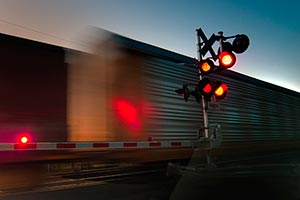Proposed Chicago Bypass Freight Railroad Could Have Capacity for 110 Trains a Day

A Great Lakes Basin Railroad forecast shows as many as 60 trains riding its rails daily through southern Lake and Porter counties in Indiana by its third year of operations, with that number declining to the low 50s and finally to 22 at the railroad's eastern terminus in LaPorte County.
The freight trains would have an average of 100 cars, pulled by two locomotives, and would travel at maximum speeds approaching 60 miles per hour, according to a report Great Lakes Basin Transportation filed Nov. 10 with the federal Surface Transportation Board.
RELATED: Feds want more info on proposed Great Lakes Basin freight railroad
The railroad's signaling and train-control infrastructure would allow 110 trains per day, a number that has raised protests among opponents. It is being engineered for speeds up to 70 mph, though average speed would depend on traffic volume.
The latest forecasts were done at the behest of the STB's Office of Environmental Assessment, which oversees development of the Environmental Impact Statement for major rail projects.
Traffic would grow through the first three years of operations, according to the forecast, with 10 to 15 trains daily through most of Northwest Indiana in the first year and 20 to 30 the second year.
RELATED: Controversial proposal for $8 billion private freight rail to bypass congested Chicago
The Great Lakes Basin Railroad would run 258 miles from the LaPorte area through Illinois to Milton, Wisconsin.
Near the center of that is a proposed "railport" near Manteno, Illinois, where traffic could top 80 trains on the highest-traffic days, according to Great Lakes Basin's projections.
Railroad President James Wilson cautioned in a letter accompanying the forecast that they depend on a variety of factors.
"These include the level of economic activity when construction of the line is completed, the types and volumes of rail freight traffic that would be transiting through the Chicago area at that time and the business decisions of GLBR's connecting railroads and their shippers," he wrote.
The Nov. 10 submission was in response to the Office of Environmental Assessment's second information request regarding the Great Lakes Basin Railroad. The first regarded the railroad's preferred route and potential alternative alignments.
That request resulted in a new route that adjusted the railroad's path through Northwest Indiana, including moving it farther from Lowell Middle School. Railroad officials said the route would allow construction of the infrastructure necessary to support trains of the size and speed necessary for the project's viability.
Subsequent to that, the LaPorte County Board of Commissioners joined other local government bodies in objecting to the project, saying in a resolution that the railroad used too much "greenfield ... and makes inadequate use of less intrusive, existing railroad right of way."
The OEA made a third information request on Oct. 11. That request asked for more detail on the railroad's route, including its connection to the South Shore Freight railroad at Kingsbury. The OEA also is requesting "the end-to-end travel time and corresponding rail line length, above which the project would not be commercially feasible."
The request also asks Great Lakes Basin to identify any "anchor points" along its preferred route that are necessary for the project to remain feasible. The railroad's response is due Nov. 30.
Distributed by Tribune Content Agency, LLC




